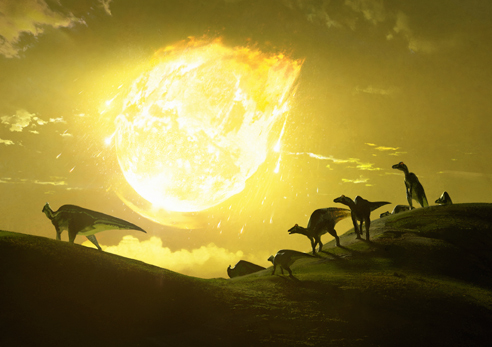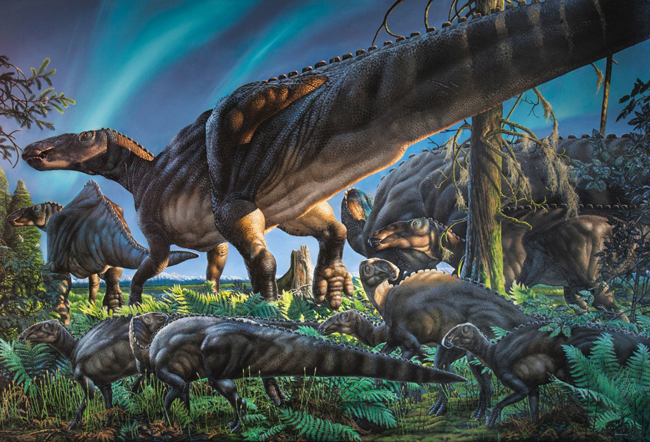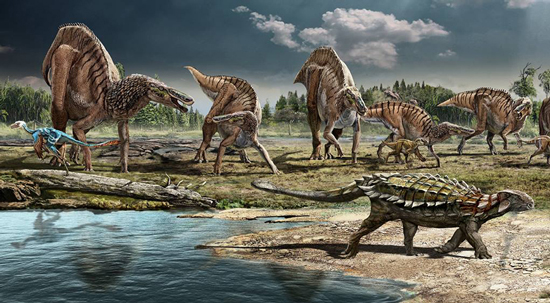The Dinosauria Not in Decline Prior to Mass Extinction Event
Dinosaur Diversification Rates not in Decline at the End of the Cretaceous
A team of international researchers including scientists from the London Natural History Museum and the University of Bath have undertaken an extensive and sophisticated statistical analysis to try to establish whether the dinosaurs were in terminal decline prior to the end-Cretaceous mass extinction event that saw the demise of all non-avian forms.
Studying the Dinosaurs at the End of the Cretaceous
The detailed Bayesian analysis suggests had the extra-terrestrial object not hit planet Earth, then the dinosaurs might have continued to dominate terrestrial ecosystems.
If the Bolide (Extra-terrestrial Object) had not Hit – Would the Non-avian Dinosaurs Still be Around Today?

Picture credit: Chase Stone
How quickly the non-avian dinosaurs died out and what sort of health dinosaur populations were in around 66 million years ago has proved to be one of the most contentious issues in vertebrate palaeontology. Some scientists argue that there were fewer genera of dinosaurs present in the Maastrichtian faunal stage of North America than in the preceding Campanian. They propose that this is evidence to suggest that the non-avian members of the Dinosauria were in decline long before their final extinction. Other scientists present data to support the idea that new species were still evolving and that the “terrible lizards” were showing no signs of being under population stress.
Were the Dinosaurs in Decline Prior to the K-Pg Extinction Event?

Picture credit: James Havens
The Extinction of the Dinosaurs
Extensive disagreements remain over whether the extinction of the dinosaurs was a sudden catastrophic event, essentially instantaneous when measured in deep, geological time or whether their ultimate die-off was the culmination of long-term evolutionary trends.
Writing in the open-access, on-line journal “Royal Society Open Science”, the researchers which include Professor Paul Barrett (London Natural History Museum) and PhD student Joe Bonsor (University of Bath), used sophisticated Bayesian statistical analysis to model three competing theories against a variety of taxonomies and phylogenies representing the Dinosauria.
In essence, the study set out to test the match between three competing hypotheses with regards to the dinosaur species-richness during the Late Cretaceous:
1). No evidence of a global downturn in dinosaur speciation rates prior to the end of the Mesozoic.
2). There was a decline in dinosaur species-richness over a timescale of hundreds of thousands or several million years prior to the bolide impact due to the effect of climate change, rising sea levels and the Deccan flood basalt volcanism (plus other factors).
3). That the Dinosauria were in global decline with falling speciation rates from around 100 million years ago.
Twelve Phylogenies Analysed
Bayesian statistical analysis was used to assess the fit of twelve dinosaur phylogenies from various authors. The researchers did not find strong support for the downturn model in their analyses, which suggests that dinosaur speciation rates were not in terminal decline prior to the K-Pg boundary and that the Dinosauria was still capable of generating new taxa and evolving into new species to exploit resources and environmental opportunities.
Dinosaurs Dominated Terrestrial Ecosystems

Picture credit: Zhao Chuang
Urging Caution
The researchers did urge caution when it came to interpreting the results of the models stating that they may be too simplified and therefore not able to reflect the complexities of the underlying data. To help confirm the state of dinosaur populations prior to the K-Pg extinction event the research team concluded that the collection of more dinosaur occurrence data would be needed to test these ideas and to validate any proposed hypothesis.
The scientific paper: “Dinosaur diversification rates were not in decline prior to the K-Pg boundary” by Joseph A. Bonsor, Paul M. Barret, Thomas J. Raven and Natalie Cooper published by Royal Society Open Science.
Visit the Everything Dinosaur website: Dinosaur Toys.

